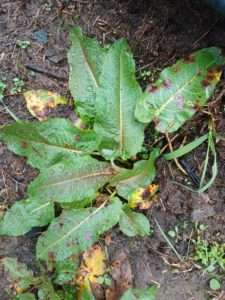Happy Spring, everyone! It’s truly my favorite time of the year, as the days lengthen, the plants start to green up and put on fresh growth, and invertebrates begin to shake off winter’s chill and make their way back into the world again. I’ve been spending a lot of time out in my garden, which I’ve been preparing for the arrival of a slew of native plants. It’s also a wonderful time for foraging for spring greens!
Granted, I’m lucky here on the coast; our winters are mild enough here that I can graze on most of these greens throughout the year. But spring means tender young leaves that are better for things like salads and pesto, while older leaves are best boiled, steamed, or stewed. And some of these plants even produce edible flowers!
Today, I want to share a few of my favorite edible spring greens that are found here on the farm; it’s hardly a complete list of all the spring edibles, of course. Please use this as a starting point for your foraging, and always use other resources like field guides to verify your identifications. When foraging for spring greens or any other wild foods, always try a small amount of a new plant or mushroom first; even if it is edible, it’s always possible you could be in the minority of folks who end up having an allergic reaction or sensitivity. Plus some edible plants have compounds in them that can be harmful in large quantities, especially if the plant is eaten raw.
As always it is very, very, very important that you not eat ANYTHING that you are not 120% sure is safe to eat!!!
(Please note that some of these plants are also mentioned in my book Winter Foraging: Forty (Or So) Wild Foods to Look For, so some of this material may look familiar to those who have read it!)
Broadleaf Plaintain (Plantago major) and Ribwort Plantain (Plantago lanceolata)

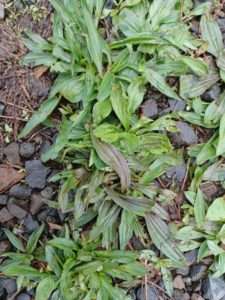 This time of year the leaves of plantain usually grow in a flat rosette at the ground, though larger specimens may get some extra volume in that regard. Notice the spoon-shaped leaves of broadleaf plantain versus the narrower, spear-shaped leaves of ribwort. Both species have parallel veins that run the entire length of the leaf; if you pluck a leaf you’ll often see the ends of the leaves sticking out of the stem. Later in the year they’ll develop their seed heads on thin green stems clustered in the center of the plant. Broadleaf has flowers and then seeds along most of the length of the stem, while ribwort has a small seed head right at the end of a long stem. Young plantain leaves are good raw, though older ones need to be cooked. Young, green seeds (especially broadleaf) are also edible, and I like to saute them. Please note that Rugel’s or blackseed plantain (Plantago rugelii), which is a native species, is very similar to broadleaf, but can be differentiated from the non-native species by a red or purple coloration at the base of the stem of each leaf.
This time of year the leaves of plantain usually grow in a flat rosette at the ground, though larger specimens may get some extra volume in that regard. Notice the spoon-shaped leaves of broadleaf plantain versus the narrower, spear-shaped leaves of ribwort. Both species have parallel veins that run the entire length of the leaf; if you pluck a leaf you’ll often see the ends of the leaves sticking out of the stem. Later in the year they’ll develop their seed heads on thin green stems clustered in the center of the plant. Broadleaf has flowers and then seeds along most of the length of the stem, while ribwort has a small seed head right at the end of a long stem. Young plantain leaves are good raw, though older ones need to be cooked. Young, green seeds (especially broadleaf) are also edible, and I like to saute them. Please note that Rugel’s or blackseed plantain (Plantago rugelii), which is a native species, is very similar to broadleaf, but can be differentiated from the non-native species by a red or purple coloration at the base of the stem of each leaf.
Hairy Bittercress/Popweed (Cardamine hirsuta)
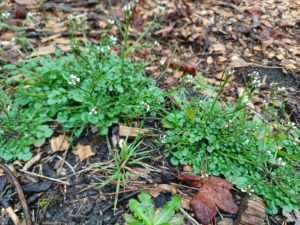 The bane of gardeners all over, hairy bittercress gets its “popweed” moniker because of its seeds. Once they’re mature, the barest touch will cause them to fly vigorously away from the plant, often landing several feet away. It’s best to pick this plant before that point anyway, since it will still be nice and tender. A member of the Brassicaceae, it has a strong, somewhat mustardy flavor that may be rendered a bit milder with cooking, or cutting with milder plants like plantain.
The bane of gardeners all over, hairy bittercress gets its “popweed” moniker because of its seeds. Once they’re mature, the barest touch will cause them to fly vigorously away from the plant, often landing several feet away. It’s best to pick this plant before that point anyway, since it will still be nice and tender. A member of the Brassicaceae, it has a strong, somewhat mustardy flavor that may be rendered a bit milder with cooking, or cutting with milder plants like plantain.
Common Dandelion (Taraxacum officinale) and Hairy Cat’s Ear (Hypochaeris radicale)
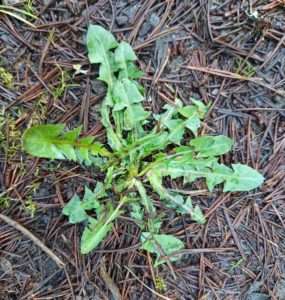
 The common dandelion is likely the most recognizable “weed” in the United States, and many places otherwise. This hardy plant is entirely edible other than the stem, which has a bitter latex in it. There are several similar plants in the family Asteraceae that have the same sort of yellow flowers that turn to white seed puffs, and deeply lobed, long leaves in a rosette at the base. One that is very common where I live is the hairy cat’s ear, and luckily for me both species can be eaten similarly. Like plantain, the young leaves are good fresh and raw, though some may find the flavor too strong to be eaten alone. Steaming or other cooking can render them more palatable, and make older leaves less tough. The flowers are also good tossed into a salad, and can even be battered and fried for a quick snack! Note that dandelion leaves are more deeply lobed with sharper “points” that often point back toward the center of the plant. Also, once the plants begin to flower, common dandelion has one flower per fleshy, hollow stem, while the solid stems of hairy cat’s ear branch partway up, with each sub-branch having one flower.
The common dandelion is likely the most recognizable “weed” in the United States, and many places otherwise. This hardy plant is entirely edible other than the stem, which has a bitter latex in it. There are several similar plants in the family Asteraceae that have the same sort of yellow flowers that turn to white seed puffs, and deeply lobed, long leaves in a rosette at the base. One that is very common where I live is the hairy cat’s ear, and luckily for me both species can be eaten similarly. Like plantain, the young leaves are good fresh and raw, though some may find the flavor too strong to be eaten alone. Steaming or other cooking can render them more palatable, and make older leaves less tough. The flowers are also good tossed into a salad, and can even be battered and fried for a quick snack! Note that dandelion leaves are more deeply lobed with sharper “points” that often point back toward the center of the plant. Also, once the plants begin to flower, common dandelion has one flower per fleshy, hollow stem, while the solid stems of hairy cat’s ear branch partway up, with each sub-branch having one flower.
Chickweed (Stellaria medea)
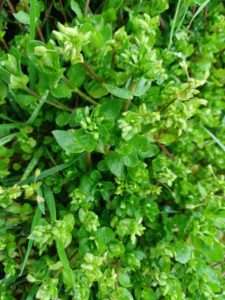 This is one of those plants that, while edible, you want to limit your intake of. The leaves are full of saponins, which can be harmful in large quantities, especially for those who are pregnant or breastfeeding (you may want to just avoid it entirely if you’re in one of those categories.) It’s good raw, though I like it steamed. The picture I took on a rainy day, which means the little white five-petaled flowers were closed.
This is one of those plants that, while edible, you want to limit your intake of. The leaves are full of saponins, which can be harmful in large quantities, especially for those who are pregnant or breastfeeding (you may want to just avoid it entirely if you’re in one of those categories.) It’s good raw, though I like it steamed. The picture I took on a rainy day, which means the little white five-petaled flowers were closed.
Dock (Rumex spp., including R. crispus and R. obtusifolius, and R. acetosella, “sheep sorrel”)
While it’s likely too late for the edible seeds of Rumex spp., the leaves are edible year-round. The high oxalic acid content in the leaves means you probably want to boil these a few times and discard the water each time; a buildup of oxalic acid can cause serious issues in your kidneys and urinary tract. Consume in moderation. Note that R. crispus (not pictured) and R. obtusifolius have rather large, heavily textured leaves that can be almost a foot long, while R. acetosella has smaller, lance-shaped leaves that are smoother.
Red Deadnettle (Lamium purpureum)
 I have a love-hate relationship with this plant. On the one hand, it’s an invasive species from Eurasia, and I don’t want to encourage it to grow here. On the other? It’s really, really pretty. There’s a patch on a part of the farm that’s about to be torn up, and I’m tempted to grab a small handful to put in a pot of soil. The new leaves and flowers at the tip are nice in salads and sautees; the older leaves often may be too tough for some people even when cooked. It looks very similar to purple henbit (Lamium amplexicaule, not pictured) which, thankfully, is also edible. Note the mint-like, heart-shaped leaves that have the characteristic pinkish tint on new growth. Despite the nettle in its name, it does not have irritating hairs like stinging nettle (Urtica dioica, not pictured.)
I have a love-hate relationship with this plant. On the one hand, it’s an invasive species from Eurasia, and I don’t want to encourage it to grow here. On the other? It’s really, really pretty. There’s a patch on a part of the farm that’s about to be torn up, and I’m tempted to grab a small handful to put in a pot of soil. The new leaves and flowers at the tip are nice in salads and sautees; the older leaves often may be too tough for some people even when cooked. It looks very similar to purple henbit (Lamium amplexicaule, not pictured) which, thankfully, is also edible. Note the mint-like, heart-shaped leaves that have the characteristic pinkish tint on new growth. Despite the nettle in its name, it does not have irritating hairs like stinging nettle (Urtica dioica, not pictured.)
Miner’s Lettuce (Claytonia perfoliata)
 The only native in this list, miner’s lettuce is a wonderfully fresh-tasting plant whose leaves do have a crispy texture like a nice, fresh lettuce (something nicer than iceberg, anyway.) It is similar to Siberian miner’s lettuce, or candy flower (Claytonia sibirica, not pictured), except the latter often has a red to purple coloration on the stem. C. perfoliata has unusual round green leaves around the tiny white flowers, which C. sibirica does not have. Similar to spinach, miner’s lettuce has large amounts of soluble oxalates, so consume in moderation.
The only native in this list, miner’s lettuce is a wonderfully fresh-tasting plant whose leaves do have a crispy texture like a nice, fresh lettuce (something nicer than iceberg, anyway.) It is similar to Siberian miner’s lettuce, or candy flower (Claytonia sibirica, not pictured), except the latter often has a red to purple coloration on the stem. C. perfoliata has unusual round green leaves around the tiny white flowers, which C. sibirica does not have. Similar to spinach, miner’s lettuce has large amounts of soluble oxalates, so consume in moderation.
Again, these are just what I can easily find when foraging for spring greens on the farm I live on; there’s plenty more out there to enjoy! Also, please don’t over-harvest native plants like Rugel’s plantain or miner’s lettuce, but do feel free to take as much of the non-native invasive plants as you like (just consume in moderation where noted.)
